Related Research Articles

The Ericales are a large and diverse order of dicotyledons. Species in this order have considerable commercial importance including for tea, persimmon, blueberry, kiwifruit, Brazil nuts, argan, cranberry, sapote, and azalea. The order includes trees, bushes, lianas, and herbaceous plants. Together with ordinary autophytic plants, the Ericales include chlorophyll-deficient mycoheterotrophic plants and carnivorous plants.
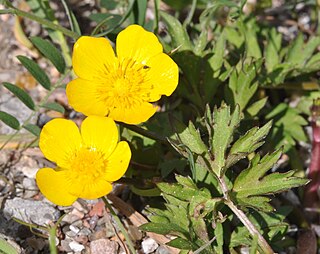
Flowering plants are plants that bear flowers and fruits, and form the clade Angiospermae. The term 'angiosperm' is derived from the Greek words ἀγγεῖον / angeion and σπέρμα / sperma ('seed'), meaning that the seeds are enclosed within a fruit. The group was formerly called Magnoliophyta.
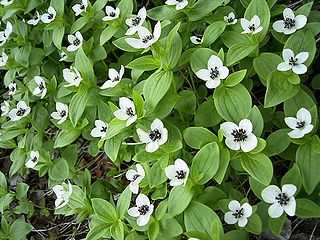
The Cornaceae are a cosmopolitan family of flowering plants in the order Cornales. The family contains approximately 85 species in two genera, Alangium and Cornus. They are mostly trees and shrubs, which may be deciduous or evergreen, although a few species are perennial herbs. Members of the family usually have opposite or alternate simple leaves, four- or five-parted flowers clustered in inflorescences or pseudanthia, and drupaceous fruits. The family is primarily distributed in northern temperate regions and tropical Asia. In northern temperate areas, Cornaceae are well known from the dogwoods Cornus.
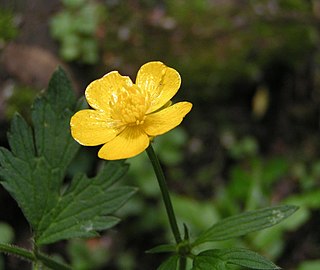
Ranunculales is an order of flowering plants. Of necessity it contains the family Ranunculaceae, the buttercup family, because the name of the order is based on the name of a genus in that family. Ranunculales belongs to a paraphyletic group known as the basal eudicots. It is the most basal clade in this group; in other words, it is sister to the remaining eudicots. Widely known members include poppies, barberries, hellebores, and buttercups.

Ranunculaceae is a family of over 2,000 known species of flowering plants in 43 genera, distributed worldwide.

Geraniales is a small order of flowering plants, included within the rosid subclade of eudicots. The largest family in the order is Geraniaceae with over 800 species. In addition, the order includes the smaller Francoaceae with about 40 species. Most Geraniales are herbaceous, but there are also shrubs and small trees.
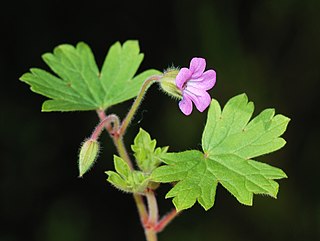
Geraniaceae is a family of flowering plants placed in the order Geraniales. The family name is derived from the genus Geranium. The family includes both the genus Geranium and the garden plants called geraniums, which modern botany classifies as genus Pelargonium, along with other related genera.

Pelargonium is a genus of flowering plants that includes about 280 species of perennials, succulents, and shrubs, commonly called geraniums, pelargoniums, or storksbills. Geranium is also the botanical name and common name of a separate genus of related plants, also known as cranesbills. Both genera belong to the family Geraniaceae, and Carl Linnaeus originally included all the species in one genus, Geranium; they were later separated into two genera by Charles Louis L'Héritier de Brutelle in 1789.

Actaea racemosa, the black cohosh, black bugbane, black snakeroot, rattle-top, or fairy candle, is a species of flowering plant of the family Ranunculaceae. It is native to eastern North America from the extreme south of Ontario to central Georgia, and west to Missouri and Arkansas. It grows in a variety of woodland habitats, and is often found in small woodland openings.

Cyclamen is a genus of 23 species of perennial flowering plants in the family Primulaceae. In English, it is known by the common names sowbread or swinebread. Cyclamen species are native to Europe and the Mediterranean Basin east to the Caucasus and Iran, with one species in Somalia. They grow from tubers and are valued for their flowers with upswept petals and variably patterned leaves.

Hemerocallidoideae is a subfamily of flowering plants, part of the family Asphodelaceae sensu lato in the monocot order Asparagales according to the APG system of 2016. Earlier classification systems treated the group as a separate family, the Hemerocallidaceae. The name is derived from the generic name of the type genus, Hemerocallis. The largest genera in the group are Dianella, Hemerocallis (15), and Caesia (11).

Actaea, commonly called baneberry, bugbane and cohosh, is a genus of flowering plants of the family Ranunculaceae, native to subtropical, temperate and subarctic regions of Europe, Asia and North America.

Siparunaceae is a family of flowering plants in the magnoliid order Laurales. It consists of two genera of woody plants, with essential oils: Glossocalyx in West Africa and Siparuna in the neotropics. Glossocalyx is monospecific and Siparuna has about 74 known species.

Peridiscaceae is a family of flowering plants in the order Saxifragales. Four genera comprise this family: Medusandra, Soyauxia, Peridiscus, and Whittonia., with a total of 12 known species. It has a disjunct distribution, with Peridiscus occurring in Venezuela and northern Brazil, Whittonia in Guyana, Medusandra in Cameroon, and Soyauxia in tropical West Africa. Whittonia is possibly extinct, being known from only one specimen collected below Kaieteur Falls in Guyana. In 2006, archeologists attempted to rediscover it, however, it proved unsuccessful.

Huerteales is the botanical name for an order of flowering plants. It is one of the 17 orders that make up the large eudicot group known as the rosids in the APG III system of plant classification. Within the rosids, it is one of the orders in Malvidae, a group formerly known as eurosids II and now known informally as the malvids. This is true whether Malvidae is circumscribed broadly to include eight orders as in APG III, or more narrowly to include only four orders. Huerteales consists of four small families, Petenaeaceae, Gerrardinaceae, Tapisciaceae, and Dipentodontaceae.
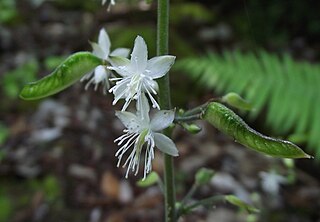
Beesia is a genus of flowering plants in the buttercup family. It was named in 1915 after the plant nursery firm Bees of Chester, who financed the plant hunting trips of George Forrest and Frank Kingdon-Ward in China.

Cardiopteridaceae is a eudicot family of flowering plants. It consists of about 43 species of trees, shrubs, and woody vines, mostly of the tropics, but with a few in temperate regions. It contains six genera, the largest of which is Citronella, with 21 species. The other genera are much smaller.
When the APG II system of plant classification was published in April 2003, fifteen genera and three families were placed incertae sedis in the angiosperms, and were listed in a section of the appendix entitled "Taxa of uncertain position".

Pelargonium coronopifolium is a subshrub of up to 40 cm high. It has green to slightly greyish, linear to narrowly elliptical leaves often with irregular teeth towards the tip and white to purple flowers in groups of one to four. It can be found in the Western Cape province of South Africa. Old publications suggested the name buck's horn plantain-leaved stork's bill, but this name never gained common use.
Professor Mary Gibby was a British botanist, pteridologist and cytologist. She was an expert on ferns, becoming president of the British Pteridological Society and long-time editor of its journal, the Fern Gazette. Gibby particularly studied the cytology of the genera Dryopteris and Pelargonium.
References
- ↑ Forest fire's environmental impact could last a decade Archived 29 October 2013 at the Wayback Machine , .
- ↑ Coco-de-mer arrives at Reading University Herbarium,.
- ↑ Yesson, C. and Culham, A. (2006) Phyloclimatic modeling: Combining phylogenetics and bioclimatic modeling. Systematic Biology, 55 (5). pp. 785–802. ISSN 1063-5157 doi : 10.1080/1063515060081570
- ↑ Heywood, V. and Culham, A. (2009) The impacts of climate change on plant species in Europe. Report T-PVS/Inf9E. In: Convention on the conservation of European wildlife and natural habitats. 29th meeting of the Standing Committee, Bern.
- ↑ Yesson, C., Toomey, N. H. and Culham, A. (2009) Cyclamen: time, sea and speciation biogeography using a temporally calibrated phylogeny. Journal of Biogeography, 36 (7). pp. 1234–1252. ISSN 0305-0270 doi : 10.1111/j.1365-2699.2008.01971.x
- ↑ Yesson, C., Brewer, P. W., Sutton, T., Caithness, N., Pahwa, J. S., Burgess, M., Gray, W. A., White, R. J., Jones, A. C., Bisby, F. A. and Culham, A. (2007) How global is the global biodiversity information facility? PLoS ONE, 2 (11). p. 1124. ISSN 1932-6203 doi : 10.1371/journal.pone.0001124
- ↑ Heap, M. J. and Culham, A. (2010) Automated pre-processing strategies for species occurrence data used in biodiversity modelling. Lecture Notes in Computer Science: Lecture Notes in Artificial Intelligence, Part I (6279). pp. 517–526. ISSN 0302-9743 doi : 10.1007/978-3-642-15384-6
- ↑ Bakker, F. T., Culham, A., Pankhurst, C. E. and Gibby, M. (2000) Mitochondrial and chloroplast DNA-based phylogeny of Pelargonium (Geraniaceae). American Journal of Botany, 87 (5). pp. 727–734. ISSN 1537-2197
- ↑ Bakker, F.T., Culham, A., Hettiarachi, P. , Touloumenidou, T. and Gibby, M. (2004) Phylogeny of Pelargonium (Geraniaceae) based on DNA sequences from three genomes. Taxon, 53 (1). pp. 17–28. ISSN 0040-0262
- ↑ Bakker, F.T., Culham, A., Marais, E.M. and Gibby, M. (2005) Nested radiation in Cape Pelargonium. In: Bakker, F.T., Chatrou, L.W., Gravendeel, B. and Pelser, P.B. (eds.) Plant Species-Level Systematics: New Perspectives on Pattern & Process. Gantner Verlag, Rugell, Liechtenstein. ISBN 9783906166391
- ↑ Compton JA, Culham A, Jury SL. 1998 Reclassification of Actaea to include Cimicifuga and Souliea (Ranunculaceae): phylogeny inferred from morphology, nrDNA ITS, and cpDNA trnL-F sequence variation. Taxon 47 (3): 593–634
- ↑ Compton, J.A. and Culham, A. Phylogeny and circumscription of tribe Actaeeae Ranunculaceae. Systematic Botany, 27 (3) July–September 2002, 502–511.
- ↑ Compton, J.A., Clennett, J.C.B. and Culham, A. (2004) Nomenclature in the dock. Overclassification leads to instability: a case study in the horticulturally important genus Cyclamen (Myrsinaceae). Botanical Journal of The Linnean Society, 146 (3). pp. 339–349. ISSN 0024-4074 doi : 10.1111/j.1095-8339.2004.00322.x
- ↑ Maunder, M., Culham, A., Alden, B., Zizka, G., Orliac, C., Lobin, W., Bordeu, A., Ramirez, J.M. and Glissmann-Gough, S. Conservation of the toromiro tree: Case study in the management of a plant extinct in the wild. Conservation Biology, 14(5), 2000, 1341–1350.
- ↑ Hunt for Easter tree, Times Higher,
- ↑ Mishra, P.K., Fox, R.T.V. and Culham, A. (2003) Development of a PCR-based assay for rapid and reliable identification of pathogenic Fusaria. FEMS Microbiology Letters, 218 (2). pp. 329–332. ISSN 0378-1097 doi : 10.1111/j.1574-6968.2003.tb11537.x
- ↑ Mishra, P.K., Fox, R.T.V. and Culham, A. (2003) Inter-simple sequence repeat and aggressiveness analyses revealed high genetic diversity, recombination and long-range dispersal in Fusarium culmorum. Annals of Applied Biology, 143 (3). pp. 291–301. ISSN 0003-4746 doi : 10.1111/j.1744-7348.2003.tb00297.x
- ↑ "Project organisation – i4life". University of Reading. Retrieved 20 December 2012.
- ↑ Heywood, V.H. , Brummit, R.K., Culham, A. and Seberg, O. (2007) Flowering plant families of the world. Kew Books (Europe) Firefly Books (North America). ISBN 9781554072064
- ↑ International Plant Names Index. Culham.